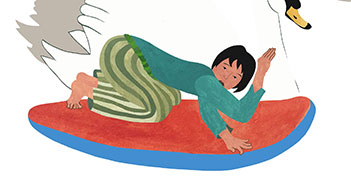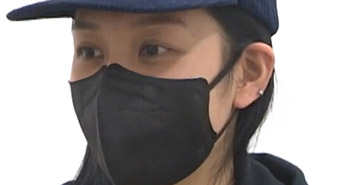인천아트플랫폼 입주작가 소개
올해 한 해 인천아트플랫폼에서 창작활동을 펼쳐나갈 2019년도 10기 입주 예술가를 소개합니다. 인천아트플랫폼 레지던시는 공모로 선정된 국내외 다양한 장르 예술가들의 창작 역량 강화를 위해 비평 및 연구 프로그램, 창·제작 발표지원 프로그램 등을 운영합니다. 한 달에 두 번, 인천문화통신 3.0을 통해 시각과 공연분야에서 활동하는 10기 입주 예술가의 창작과정과 작업세계를 공개합니다. 많은 관심 부탁드립니다.
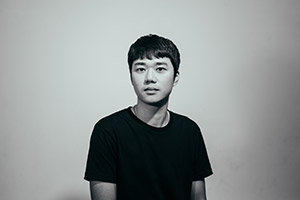 LIAO Chao-Hao is a Taiwan-based visual artist. He earned his bachelor’s degree from the Department of Fine Art at Taipei National University of Arts (TNUA), and earned his master’s degree from Graduate Institute of Plastic Arts at Tainan National University of the Arts. He has won prizes at the 2015 Kaohsiung Art Awards, as well as the New Taipei City Art Exhibition and the Exhibition of the Newly Emerging Artists in Taiwan. Chao-Hao participated in this year’s first artist exchange program between the Incheon Art Platform and Taiwan’s Pier-2 Art Center, where he works and stays from June to August.
LIAO Chao-Hao is a Taiwan-based visual artist. He earned his bachelor’s degree from the Department of Fine Art at Taipei National University of Arts (TNUA), and earned his master’s degree from Graduate Institute of Plastic Arts at Tainan National University of the Arts. He has won prizes at the 2015 Kaohsiung Art Awards, as well as the New Taipei City Art Exhibition and the Exhibition of the Newly Emerging Artists in Taiwan. Chao-Hao participated in this year’s first artist exchange program between the Incheon Art Platform and Taiwan’s Pier-2 Art Center, where he works and stays from June to August.
대만 출신의 작가 랴오 차오하오는 국립 타이베이 예술대학에서 순수미술을 전공하고, 국립 타이난 예술대학에서 조형예술로 석사학위를 취득했다. 그는 2015년 가오슝 아트 어워드를 비롯하여 신베이시 미술전과 대만 신진 예술가 전시 등에서 수상한 바 있다. 올해 처음으로 진행되는 인천아트플랫폼과 대만의 피어 투 아트센터와의 작가교환 프로그램에 참여하여 6월부터 8월까지 레지던시에 머물며 활동하고 있다.
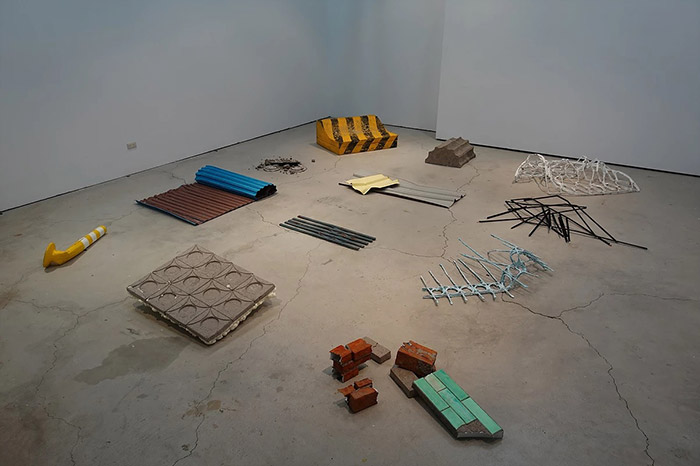 Exhibition View of ‘Geology (地質 圈)’_The Pier-2 Art Center, Kaohsiung, Taiwan_2018
Exhibition View of ‘Geology (地質 圈)’_The Pier-2 Art Center, Kaohsiung, Taiwan_2018
# Q&A
Q. Please tell us about your works, including your creation process.
A. When I started my creative work, I took observations from the environment and focused on the state of the facilities that were involved in the natural environment. I majored in sculpture in college, and I was familiar with the medium of sculpture. When faced with the objects I observed, I thought about recreating these objects with the characteristics of the materials themselves, so that these objects can be directly displayed. My works represents my thoughts. At first I tried a lot of materials and finally chose the pulp made from recycled newspapers to present these non-recyclable cement products. In my creative process, observation is the most important part. From the environmental field of my life, I will record the current situation of the environment and describe my attitude towards the current environment through creation.
Q. 창작의 관심사와 내용, 제작 과정에 대하여
A. 처음 창작 활동을 시작했을 때, 나는 환경을 관찰하고 자연환경과 관련된 시설물에 관심을 두고 있었다. 나는 대학에서 조각을 전공했기 때문에 조각적 매체에 익숙했다. 내가 관찰한 사물을 마주했을 때, 이 대상이 직접적으로 전시될 수 있도록, 재료 자체의 특징을 가지고 그 사물을 재창조하는 것에 대해 생각해보았다. 내 작업은 내 생각을 대변한다. 처음에는 많은 재료를 시도해 보았으나, 결정적으로 신문을 재활용하여 만들어진 펄프를 선택하여 재활용할 수 없는 물성인 시멘트를 묘사했다. 나의 창작 과정에서 관찰은 가장 중요한 부분을 차지한다. 내 삶의 환경적인 분야에서 관찰을 시작하여, 현재의 자연환경에 대한 상황을 기록하고, 창작을 통해 환경에 대한 나의 태도를 구체화한다.
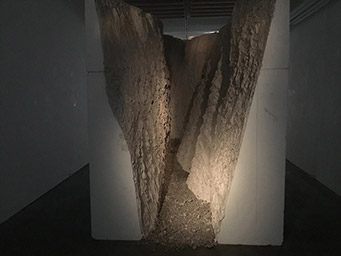 |
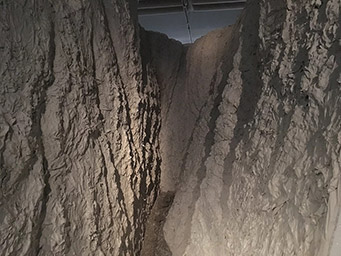 |
Mudstone (泥岩-惡地)_China clay, Soil, Pulp, Styrofoam_204×336×273cm_2017
Q. What do you think your representative work or exhibition is? Why do you think so?
A. The context of the works in each of my exhibitions is continuous, and these exhibitions can be considered as a whole. One of my work 〈Wavelet Block〉 produced in 2014 is an observation of the coast of Taiwan. And in 2015, the work of 〈Retaining Wall〉 was made for the observation of the mountain. After that, return to the most familiar urban life field and observe how the artificial objects on the road are presented in our lives. Watching each of my exhibitions at the same time, can see that I am trying to reflect the environment through the works. The interaction between the early works and the space is very high, because I want to talk about the relationship between space, objects and people. The works that have recently been presented are traces observed from objects on the roadside. The readings are used to understand time and events. I use a lot of paint to express the surface marks of these objects in an attempt to construct sculpture objects by painting.
Q. 자신이 생각하는 대표 작업(또는 전시)은 무엇이고 이 이유는 무엇인가?
A. 그간 여러 차례에 진행된 나의 전시에서 발표한 작품들의 맥락은 연속적이며, 이 전시들은 하나의 전체로서 이해할 수 있다. 2014년에는 〈消波塊(소파괴, Wavelet Block)〉 라는 작업으로 타이완의 해변을 관찰하고, 2015년에는 〈懸臂式擋土牆(현비식당토장, Retaining Wall)〉이라는 작품을 통해 산을 관찰한 결과물을 선보였다. 그 이후 가장 친숙한 도시적 삶의 공간으로 돌아와, 길 위의 인공물이 우리의 삶에서 어떻게 존재하는지에 대해 관찰을 진행했다. 지금까지 개최된 나의 전시를 살펴보면, 작품을 통해 주변 환경을 반영시키고자 한 나의 의도를 발견할 수 있다. 초창기 작업에서는 공간과 사물, 그리고 사람 사이의 관계에 대해 이야기하고 싶었기 때문에, 작업과 공간 사이의 상호 작용을 매우 중요하게 생각했다. 반면, 최근에 선보인 작업은 길가에 있는 사물을 관찰한 흔적을 나타낸 것으로, 이 흔적은 사물의 시간과 사건을 이해할 수 있는 기능을 한다. 나는 입체적 사물을 구축하기 위해 대량의 페인트를 사용하여 설치를 시도하고, 표면의 표식을 표현하고자 한다.
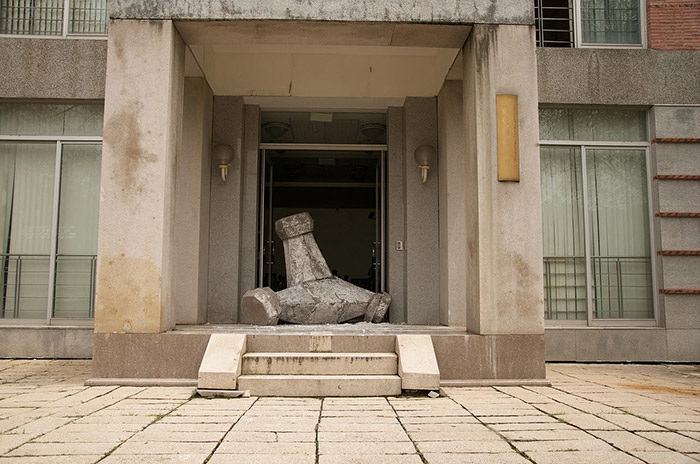 Wavelet Block (消波塊)_China clay, Soil, Pulp, Styrofoam_220×450×230cm_2017
Wavelet Block (消波塊)_China clay, Soil, Pulp, Styrofoam_220×450×230cm_2017
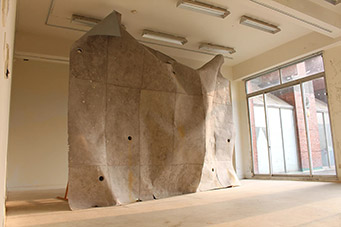 |
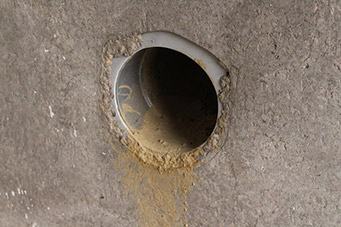 |
Retaining Wall (懸臂式擋土牆)_Pulp, Water pipe, Wood, Duct tape_250×370×240cm_2015
Q. About inspirations, motivations and episodes.
A. Interested in observing and studying on the road starting from Japan, scholars go to the street to record objects in the form of drawings and texts, and observe the phenomenon through the objects as an observation of society. It makes me think about being an artist, how to intervene in the observation of the environment through creative means, and transform into a dialogue with the audience. I like outdoor activities very much. I naturally realize the appearance of the environment at the same time. I also like to walk on the street without purpose. Some things on the road will attract my attention and let me stop to observe. I seem to be very susceptible to the call of objects. Because of these factors, I apply the learning techniques I have learned to these observations.
Q. 작업의 영감, 계기, 에피소드 등
A. 학자들은 일본에서 시작한 도로에 대한 관찰과 연구에 대한 흥미를 토대로, 거리로 나가 사물을 그림이나 문자로 기록하고, 사회를 관찰하는 방식으로써 사물을 통해 현상을 관찰했다. 이러한 방식은 내가 예술가로서 어떠한 창조적인 수단을 통해 환경 관찰에 개입할 것이며, 어떻게 관람객과 대화로 변모시킬 것인가에 대해 생각을 하도록 만든다. 나는 야외 활동을 매우 즐기는 편이며, 동시에 환경의 외관을 자연스럽게 알아차리곤 한다. 또한, 아무런 목적 없이 거리를 배회하는 것을 좋아하는데, 길가에 있는 어떠한 것들이 내 주의를 끌면, 발걸음을 멈추고 관찰한다. 아무래도 나는 사물들의 부름에 매우 민감한 편인 것 같다. 이러한 성향으로 인해 나는 내가 배운 학습 기술을 이러한 관찰에 적용하고 있다.
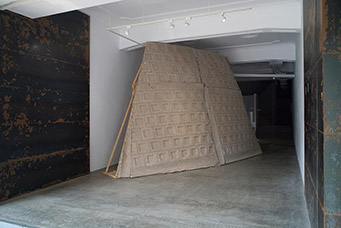 |
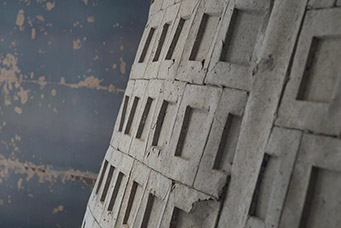 |
Slope Protection (護坡-山丘)_Pulp, Wood, PU, Foam_556×120×330cm_2017
Q. About art and communicating with audiences
A. I think that the art work coexists with the audience. The artist is a bridge that allows the work and the audience to share each other face-to-face. It is also because of the participation of the audience that my work concept is established. The objects that appear in my works are also from everyone’s daily life. The objects are related to each person’s memory. During some exhibitions, they are shared by many audiences. Their connection with these objects may come from work, memories from hometown. In the exhibition I provided a platform that provides viewers with memories of their daily life, through their sharing, to form a community profile.
Q. 예술, 그리고 관객과의 소통에 대하여
A. 나에게 예술 작품은 관람객과 공존하는 것이라고 생각한다. 작가는 작업과 관람객이 서로 마주 보고 공유할 수 있도록 다리와 같은 역할을 한다. 내 작업의 개념이 확립된 것도 작품을 보는 관람객의 참여가 있었기 때문이다. 내 작업에 등장하는 사물은 모든 이들의 일상에서 온 것이며, 사람 개개인의 기억과 관련이 있다. 몇몇 전시의 경우, 많은 사람에 의해 사물에 대한 기억이 공유된다. 이러한 사물과 관람객의 관계는 작품으로부터 비롯될 수도 있고, 고향에서의 추억으로부터 생겨났을 수도 있다. 전시에서 나는 관람객에게 이러한 공유를 통해 일상생활의 기억을 상기 시켜 공동체를 형성할 수 있는 플랫폼을 제공했다.
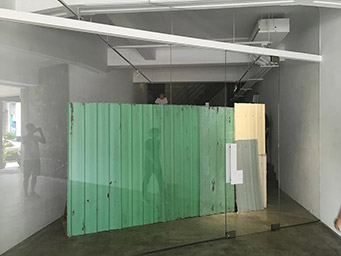 |
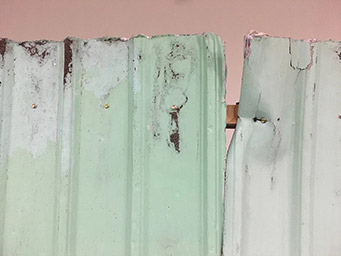 |
Sheets Fences (鐵皮圍牆)_White Glue, Pigment, Paper, Pulp, Wood_400×203×98cm_2016
Q. Please tell us about your future plans and working directions.
A. I hope to collect this project on the road, it will be a very long-term plan, including records from different countries and different cities, including records of the same country or the same city at different times, It will probably last for 10 years or it could be the records of difference in urban appearance after 20 years and the evolution of objects. In the future, the collection of re-created objects in the same space can be regarded as a system that transcends regional integration and hopes that my work will have the opportunity to become a database of objects.
Q. 앞으로 작가로서의 작업 방향과 계획에 대하여
A. 나는 동일한 국가와 도시를 다른 시간대에 기록하거나, 서로 다른 나라나 다른 도시의 길 위를 기록하는 장기적인 프로젝트를 지속하고 싶다. 그러면 아마도 10년 동안 지속할 수 있으며, 20년 후의 도시 외관에서 드러나는 차이점이나, 사물의 발전과 같은 것을 포착할 수 있을지 모른다. 훗날 같은 공간에서 재창조된 나의 작업은 각 통합된 지역을 초월한 하나의 시스템으로 나타낼 수 있으며, 나의 작품이 이러한 사물들의 데이터베이스가 되기를 희망하는 바이다.
 Flexible Delineator Post (防撞桿)_Pulp, Pigment_21×21×74cm_2016
Flexible Delineator Post (防撞桿)_Pulp, Pigment_21×21×74cm_2016
Exhibition view of ‘Artificial Series’_Crane Gallery, Kaohsiung, Taiwan_2016
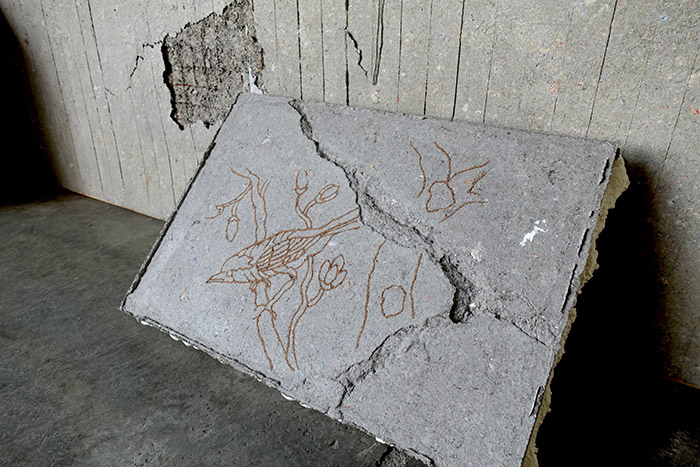 Magpie (喜鹊)_Pulp, Cork board_70x46x13cm_2019
Magpie (喜鹊)_Pulp, Cork board_70x46x13cm_2019
Q. 작품 창작의 주요 도구, 재료는?
A.

작가정보 (자세한 내용 보러가기 ▶)






